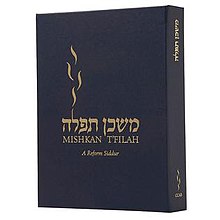Mishkan T'filah

Mishkan T'Filah Hardcover Edition
|
|
| Language | English and Hebrew |
|---|---|
| Genre | Prayer Book |
| Publisher | Central Conference of American Rabbis |
|
Publication date
|
2007 |
| Pages | 712 (Shabbat, Weekdays + Festivals Edition) |
| Preceded by | Gates of Prayer, the New Union Prayer Book |
Mishkan T'filah—A Reform Siddur is a prayer book prepared for Reform Jewish congregations around the world by the Central Conference of American Rabbis (CCAR). Mishkan T'filah (משכן תפלה) is Hebrew for "Dwelling Place for Prayer" and the book serves as a successor to the Gates of Prayer, the New Union Prayer Book (GOP), which was released in 1975. In 2015, the CCAR released the complementary Mishkan HaNefesh machzor for the High Holy Days.
Gates of Prayer was criticized as being a non-cohesive collection of prayers, resulting in a prayer book that was too large, and for its retention of masculine pronouns. To address these issues, some congregations prepared their own prayer materials (often with edits to neutralize gender) or continued use of the Union Prayer Book.
A project to address these concerns and increase the poeticism of a future prayerbook was initiated in 1981. Israeli poet T. Carmi was brought in to provide guidance on post-biblical Hebrew texts that could be incorporated into the Reform liturgy. The "Carmi Project" generated hundreds of possibilities, many of which would later be integrated into Mishkan T'filah.
A three-year study called "Lay Involvement and Liturgical Change" started in 1985 as part of an effort to better understand the changing spiritual needs of Reform worshipers. Diverse groups of volunteers were asked to keep journals regarding their experiences in prayer services as part of gaining insights into what worked well in the existing GOP prayer book, to prepare standards for evaluating new options and to start preparations for creating a revised siddur. The research found that the themed services touted as a benefit of the GOP did not meet the needs of all worshipers in aiming too narrowly at one group within the congregation and that the traditional responsive readings were found to limit participation. Feedback showed that congregants wanted accurate and meaningful translations of prayers, accompanied by a transliteration and commentaries that would provide additional insights into the text without distracting from it.
The CCAR received 18 submissions in response to requests for proposals to meet the standards specified based on the input gathered. Two proposals were selected, with one from Rabbi Elyse Frishman of the Barnert Temple in Franklin Lakes, New Jersey, who was able to provide insight on Jewish texts on liturgy and worship, who was named to serve as editor of the new siddur. In Frishman's concept, each pair of pages would feature the Hebrew text with a translation and transliteration on the right page and additional readings on the left from such authors as Yehuda Amichai and Langston Hughes.
...
Wikipedia
